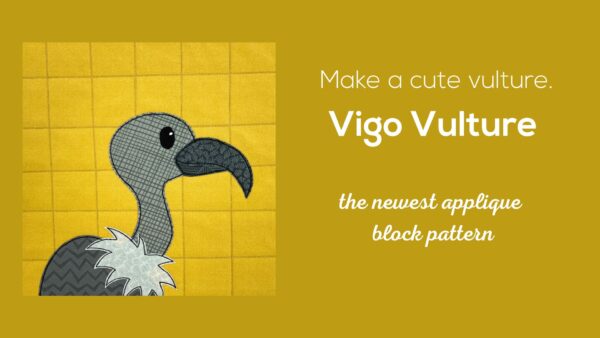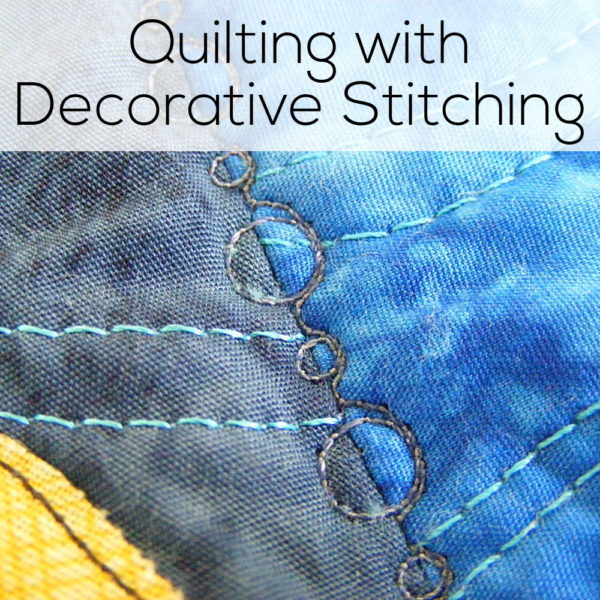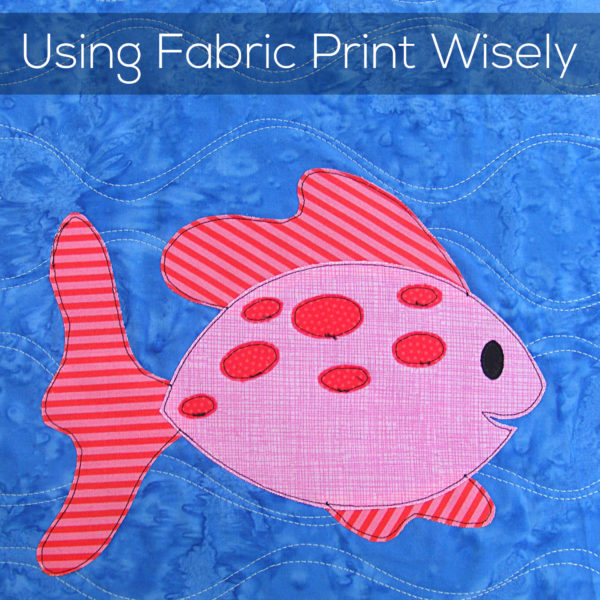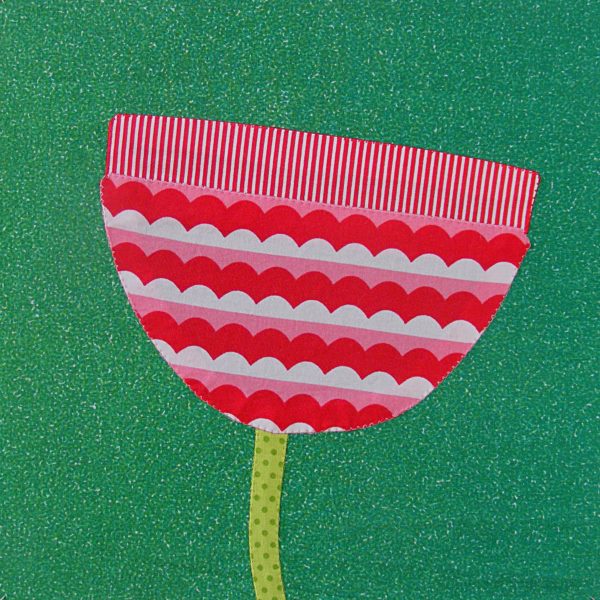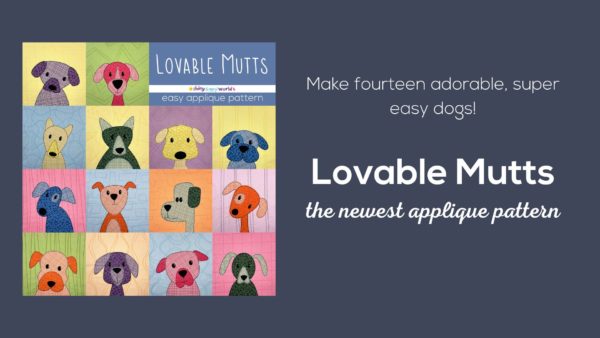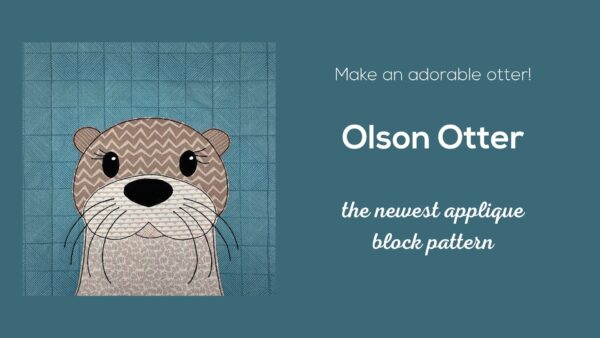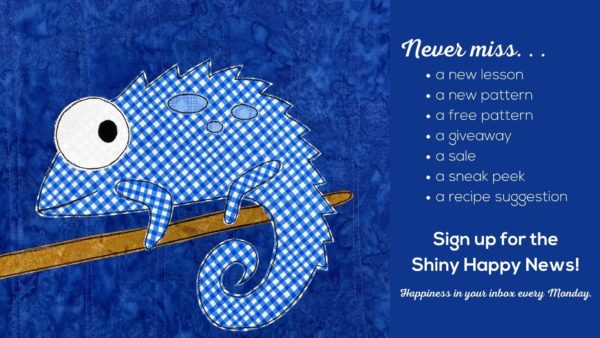The Fish Quilt pattern is finished! I did the final quilting with decorative stitches that come standard on my sewing machine. More on that in a minute.
All week I’ve been sharing peeks behind the scenes at some of the design decisions I made for my sample quilt.
In this post I showed how I quilted my background blocks in a fun wavy pattern.
In this post I talked about choosing fabric – especially the color.
In this post I talked about how to work with the print/pattern of your fabric – using the example of the striped fabric I used for some of my fish.
Today I’m talking about the final quilting.
This is different from the waves I quilted into the background blocks. This is the final round of quilting – just over the seams joining the blocks – that holds the backing to the quilt.
Usually I do either straight line quilting 1/4″ on each side of all the seams, or a fairly open and narrow zigzag over the seams.
But sometimes I find a decorative stitch on my machine that will be perfect for a quilt – and that’s what I did for this one.
Doesn’t this look like bubbles?
I used it for all the vertical seams, because streams of bubbles like this travel straight up. 🙂
For the horizontal seams I used a small wavy stitch to echo the wavy quilting within each block.
I used a variegated blue thread for both of them.
(For the Beep Beep quilt I did the final round of quilting with a decorative stitch that looked just like tire tracks. Perfect!)
Decorative stitches like the bubbly one CAN BE TRICKY – so I recommend doing some test stitching on a swatch to make sure it’s going to work for you.
The biggest problem is with stitches where the feed dogs move the quilt back and forth to achieve the stitch, instead of always steadily forward. It can be very hard to manage that back and forth motion with a large, heavy quilt in there!
Here’s where I went wrong on my quilt.
I didn’t have the quilt “fluffed” loose enough and it was hooked on the corner of my working surface. That was keeping it from feeding through properly, and you can see in the top of the photo where the stitches are all scrunched together and those bubbly circles are distorted and almost overlapping each other.
Instead of properly fixing the problem, I gave the quilt a tug – and ended up feeding the next section through too quickly, so that I made distorted wavy spirals instead of circles. 🙁
Sigh. I really know better. I slowed down and “stuffed and fluffed” properly for the rest of the quilt and everything else looks great. 🙂
(If you don’t know what I mean by “stuff and fluff” this post about quilting a full-sized quilt in a standard machine will explain.)
So – the moral of the story is. . .
It’s a lot of fun to use decorative stitching for the quilting, but only do it if you have the patience for it. If not (or if this is your first time machine quilting) use either a straight stitch, or a wide stitch that moves steadily forward, like a zigzag.
I hope some of you will share close-ups of your quilting in the Shiny Happy People Facebook group! It’s always so much fun to see what design decisions everyone else is making!
You can order the Fish Quilt pattern here.
You can order the Sea Creatures quilt pattern (designed to combine with the Fish pattern) here.

Here are all my posts about layering and basting your quilt, and the final round of quilting.
- How to Layer and Baste a Quilt Sandwich
- How to Machine Quilt
- My Favorite Tip for Machine Quilting without Swearing
- How to Quilt a Big Quilt on a Standard Sewing Machine
- What Does It Mean to Start Quilting in the Middle and Work Your Way Out?
- How to Quilt Perfectly Parallel Lines
- Tips for Quilting a Cuddle Fleece Back
- Quilting with Decorative Stitching
Here are all my posts about hand quilting and Big Stitch quilting. I don’t use these techniques with fusible applique or Quilt As You Go, but I LOVE using Big Stitch Quilting with my cheater fabric.
- How to Tie a Knot
- Hand Quilting Basics – traditional hand quilting
- Hand Quilting without Marking
- Big Stitch Quilting
- How to Quilt All the Way to the Edge
Finished with this topic?
Return to the Let’s Make a Quilt main Table of Contents.
Move on to the lessons about binding and finishing your quilt.
Happy quilting!

